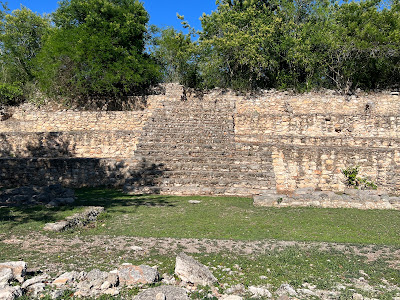Early Chinese society was shamanic and animistic. There was a cult of ancestor worship for the ruling class, and they created many bronze vessels of high technical quality for use in rituals associated with ancestor worship. They are intricately decorated with stylized images and concentric scrolls and the fineness of the casting is incredible. The had a level of mastery of the craft using the limited technology that they had, and achieved results only equaled in recent years. The bronze vessels and jade ornaments radiate a type of power, and analysis of the images reveals hallucinogenic stylized images of animals and monster faces.
The same motifs can be found on a smaller scale on the jade ornaments they made which are featured in my exhibition. These were pendants, beads, congs (squared cylindrical objects) and other small objects.
Schematic of a monster mask, toatieh mask, from a Shang Dynasty vessel about 1200 B.C.
One of the basic motifs is the toatie, a monster mask and figure spread out over the surface split bilaterally, you can see the full animal on either side of the central face. In Chinese art these monster masks feature fangs and monstrous teeth and large eyes, and show a combination of feline and bovine features. Often there are horns and fangs, an un-natural but intimidating mixture. The feet at the end of the stylized limbs are always clawed in a feline manner. Often surrounding the monster mask are tight scrolled decoration of fine raised lines, called leiwein, which may be stylized clouds filling the negative space. Over time the style changes with variations, some plain, some highly decorated but the central monster mask motif continues until the end of the archaic period. The Han Dynasty, 200 B.C. To 200 A.D., can be considered a transitional period during which the monstrous imagery of the archaic transforms to the more purely decorative styles we now associate with China.
Photograph of the monster mask on a Chinese archaic bronze vessel from the Shang Dynasty
Photograph of a Chinese bronze much like the one which the drawing above is based. Here you can see the bilaterally split creature and the lei wein scrolled decoration filing the negative spaces.
Jade cong decorated with monster masks from the late Eastern Chou Dynasty 700 -500 B.C.
This object is the heart of my exhibition. It is a jade cong with the monster mask motif carved in low relief on all four sides. A cong is a squared cylinder, with flat sides and a large round hole in the middle. It was a ritual object, whose use we don’t understand fully at this time. Usually they are early in date, Neolithic, Quijia period about 2100 to 1600 B.C., and in this case, I believe this to be a Neolithic jade cong, decorated centuries later. The Chinese had a great interest in their predecessors, and they uncovered early sites and tombs and revered the objects found there. It is an excellent example of the Chinese Monster mask, and it shows how this motif continued through the centuries of the Archaic period of Chinese history. The bilateral splitting of the figure is clear and here, the bovine elements seem to be dominant. One sees the horns and large eyes, but no fangs. But one does see at the ends of the stylized limbs the clawed paws of feline type. Also noteworthy is that the entire surface is enlivened with pattern, here rounded some of which form the monster, others seem just to fill space and others form smaller figures such one above the main mask. It is totally animated and as a result difficult for the modern eye to decipher, almost hallucinogenic.
Jade pendant of a monster mask, China Western Chou Dynasty 1000 to 700 B.C.
This small ornament, a pendant as revealed by the hole for suspension on top, relates to the prior jade in that it features monster mask with large prominent eyes, abstracted horns, and mouth that almost looks like a beak. It is almost like an owl, but really cannot be specified as it so abstracted. It dates to the Western Zhou Dynasty, thus earlier than the prior decorated cong.
Jade rectangular pendant decorated with cloud dragon motifs, Eastern Chou 7th to 5th Century B.C.
Another piece in the exhibition is from the Warring States Period or later Eastern Chou Dynasty, 7th to 5th Century B.C., in China. Carved of jade it is a rectangular pendant drilled at at one end for suspension and decorated all over with rounded relief swirl patterns that upon examination are stylized dragons. Sometimes called cloud dragons for the similarity to billowing clouds, it is very hard to read and separate one from the other. With no central image, it appears to be pure pattern until magnification reveals the cloud dragons.
Jade cylindrical bead decorated with Cloud Dragons.
China, Late Eastern Chou, 5th to 7th Century B.C.
Very similar to the rectangular pendant above, this bead is covered in curved relief decoration which on examination are revealed to be stylized dragons, that we call cloud dragons for the cloud like pattern they create.
Jade sash buckle, China Six Kingdoms period, 3rd to 6th Century A.D.
This is the latest jade in the exhibition. Difficult to date, I place it to the six Kingdom period, the period between the end of the Han Dynasty and the reunification of China under the Sui Dynasty, so 220 to 589 A.D. This includes the Northern Wei and Northern Qi Dynasties the periods from which the early Chinese Buddhist sculpture dates. I place it in this period as it is no longer archaic in style, but is more naturalistic, while still is a monstrous image. It has a lot in common with images from India and Southeast Asia of a monstrous protector of Shiva. It functioned as a sash buckle, and is rather large for a jade, with a hoop in the back through which the intercrossed sashes would be looped.


























